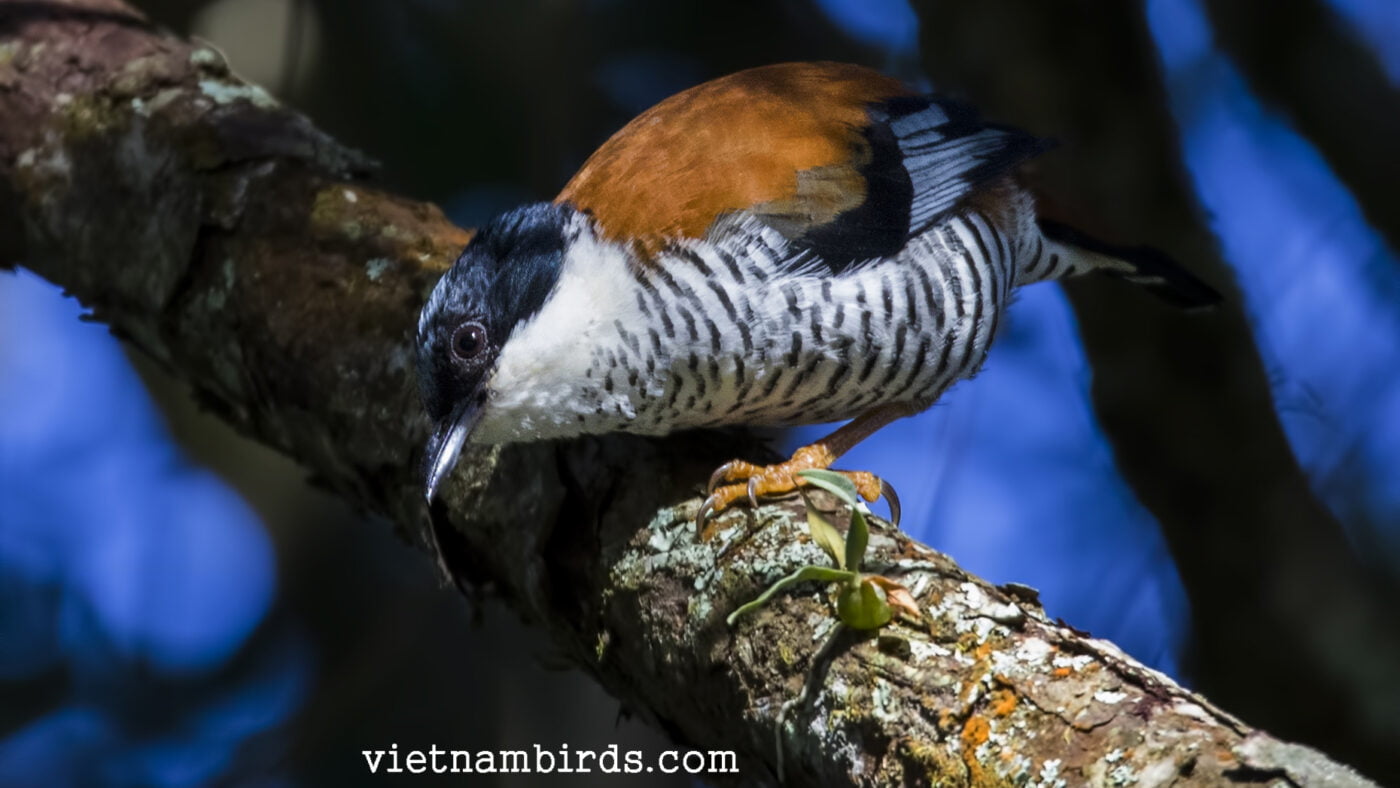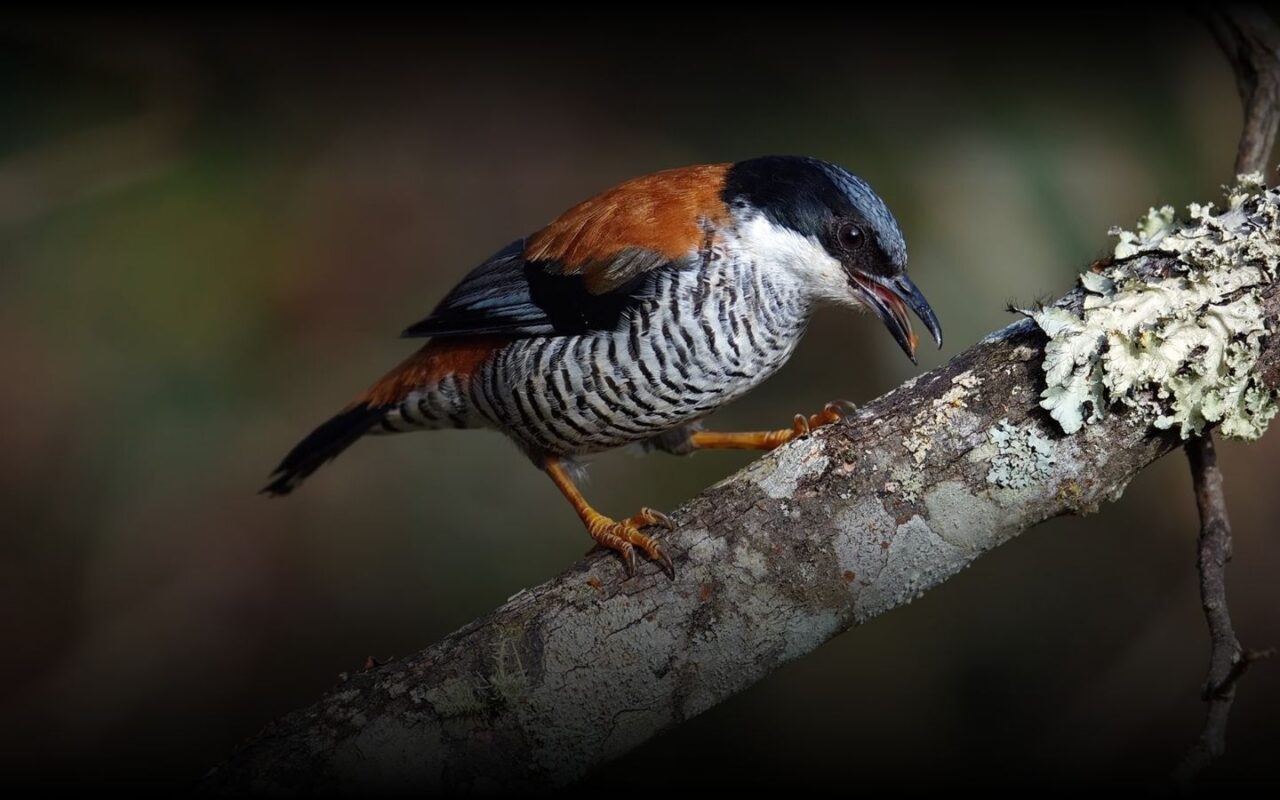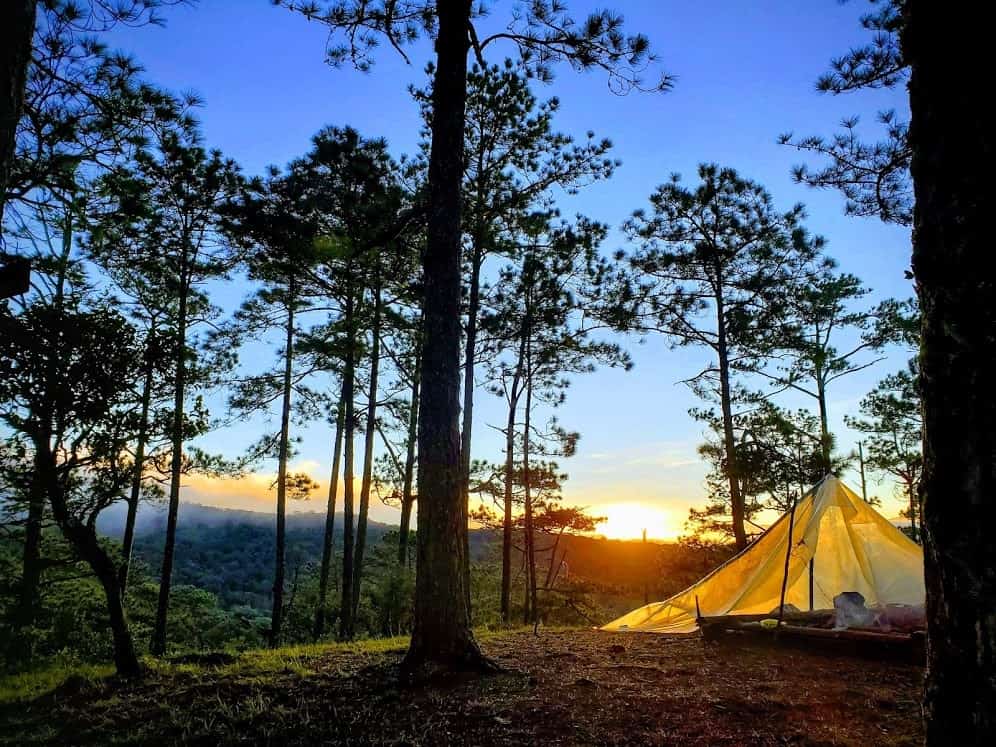Vietnamese Cutia (Cutia legalleni), an “icon bird” of the Dalat Plateau, has been found in Vietnam’s montane forests and can be spotted in Di Linh, Bidoup-Nui Ba, Chu Yang Sin, Mang Den, and Ngoc Linh.

Identification
- Appearance:
The Vietnamese Cutia is a distinctive, short-tailed babbler, measuring approximately 17.5-19.5 cm in length. The male features a bluish-tinged slate grey forehead and nape, a broad black mask across the eyes, and a white throat. The upperparts are bright rufous-chestnut, and the underparts are barred. The female shares the white throat and barred underparts but lacks the striking bluish-grey crown and chestnut upperpart features of the male. - Notable Features:
The combination of the male’s bluish-grey crown, black mask, and rufous-chestnut upperparts makes the Vietnamese Cutia easily recognizable. Unlike similar species like the Himalayan Cutia, the Vietnamese Cutia male has fully barred underparts and a distinctive facial pattern. The female’s less vivid coloration still presents a clear contrast with other species due to her white throat and barred pattern.
All info we receive from Birdlife
Habitat Preferences
- Elevation Range:
The Vietnamese Cutia is typically found at altitudes ranging from 1,200 to 2,100 meters. - Preferred Environment:
This species prefers broadleaved evergreen forests, mixed broadleaved and pine forests, and sometimes pure pine forests, particularly when close to broadleaved forest areas. It is often associated with primary forest but may also be found in secondary growth or logged forests, particularly in the canopy and sub-canopy layers. - Distribution:
The Vietnamese Cutia is primarily found in the Da Lat Plateau and the Kon Tum Plateau in Vietnam. Key regions include Bi Doup – Nui Ba National Park, Chu Yang Sin National Park, and Thuong Da Nhim Nature Reserve.

Behavioral Traits
- Foraging Behavior:
The Vietnamese Cutia forages by moving through the canopy and sub-canopy of forests, often in pairs or small groups of up to 10 birds. It feeds on insects, particularly among epiphytes, moss-covered branches, and tree bowls, showing a preference for larger trees with dense foliage. - Vocalization:
The Vietnamese Cutia produces variable and distinctive whistles, such as “wuyeet wu wi wi wi wi woo,” which it repeats every 3-6 seconds. Other common calls include “wuyeet wu weeit-wu.” These vocalizations are helpful for identifying the species in dense forest habitats.
Conservation Status
- Current Status:
The Vietnamese Cutia is classified as Near Threatened. The precautionary classification is due to its potentially small population size and a suspected slow decline resulting from habitat degradation and some level of trapping for the pet trade. - Threats:
The primary threats to the Vietnamese Cutia include deforestation for logging and agricultural expansion, particularly for coffee plantations. The species is also at risk from trapping and trading as a pet, particularly in areas around Da Lat.
How to Look for It
- Best Practices for Observation:
Birdwatchers should focus on the canopy and sub-canopy levels of evergreen or mixed broadleaved-pine forests. Early morning hours offer the best chances of spotting the species as it forages. Listening for its distinctive whistles can also guide observers to its location. - Best Seasons:
The Vietnamese Cutia can be observed year-round, but the dry season (November to April) is often the best time for birdwatching in Vietnam, as the weather is more favorable, and the birds are more active.
See the detail of recently encounter on ebird
Top 5 Locations to Spot the Vietnamese Cutia
Di Linh Town with the San Pass:
The San Pass, located near Di Linh Town, is a well-known birding spot with dense montane evergreen forests. These forests provide an ideal habitat for the Vietnamese Cutia, offering a mix of mature broadleaved trees and thick undergrowth, where the bird is often seen foraging in the canopy.
Bidoup-Nui Ba National Park:
This national park, part of the Da Lat Plateau, is characterized by its vast stretches of montane evergreen forest, ranging from 1,500 to over 2,000 meters in elevation. The Vietnamese Cutia is frequently spotted here, especially in areas with older, undisturbed forests.
Chu Yang Sin National Park:
Located in the Central Highlands, Chu Yang Sin National Park features a mix of montane evergreen and coniferous forests. The high-altitude areas of the park, with their dense canopy, are prime locations for observing the Vietnamese Cutia.
Mang Den:
Mang Den, situated on the Kon Tum Plateau, is known for its pristine montane forests. The area’s unique mix of broadleaved and coniferous trees provides excellent conditions for the Vietnamese Cutia, making it a favored spot for birdwatchers.
Ngoc Linh Nature Reserve:
This reserve is located on the border of Kon Tum and Quang Nam provinces and is home to extensive montane evergreen forests. The Vietnamese Cutia is one of the notable species found in the reserve, particularly in the higher elevation zones, where the forest remains dense and largely undisturbed.

Scheduled Wildlife Tours to spot Vietnamese Cutia at WANEE
Birdwatching tours in the Da Lat Plateau provide a great chance to spot the Vietnamese Cutia. WANEE offers several scheduled wildlife tours to explore Bi Doup – Nui Ba National Park and other prime birding spots. Accompanied with experienced local guides, these tours can greatly improve the chances of encountering this rare species.
Tailored Wildlife Tours to spot Vietnamese Cutia at WANEE
Click here to see more tailored tour options
With over 100 successful tours annually, we promise a memorable adventure, achieving above 90% of our wildlife spotting targets. Convenient accommodations and enthusiastic service ensure your satisfaction. Maybe we’re not the best, but we always try our best!
Visit our sites:
– Facebook: WANEE Vietnam (Wild and Nature Exploring)
– Instagram: WANEE Vietnam and WANEE Kids hub
Crocodile Trail – The Best Birding Trail in Cat Tien National Park
If you’re a birder or nature photographer planning a trip to Vietnam, few places offer [...]
Cong Troi Trail – Top 1 Dalat Plateau Birding Trail Experience
If you’re a birder or nature photographer planning a trip to Vietnam’s Central Highlands, the [...]
How to Identify the Greater Sand Plover, Tibetan Sand Plover and Siberian Sand Plover
ContentsTop 5 Locations to Spot the Vietnamese CutiaScheduled Wildlife Tours to spot Vietnamese Cutia at [...]
Highlights of Cat Tien National Park Reptiles and Amphibian Endemics
Spanning over 71,350 hectares of tropical forests, grasslands, and wetlands, Cat Tien National Park is [...]
Highlights of Cat Tien National Park Mammals in a World Biosphere Reserve
In addition to reptiles and birds, Cat Tien National Park is also rich in mammals, [...]
Kontum Plateau Endemic and Highlight bird
Kontum Plateau Endemic And Highlight Bird species like Chestnut-eared Laughingthrush and top birding routes while [...]